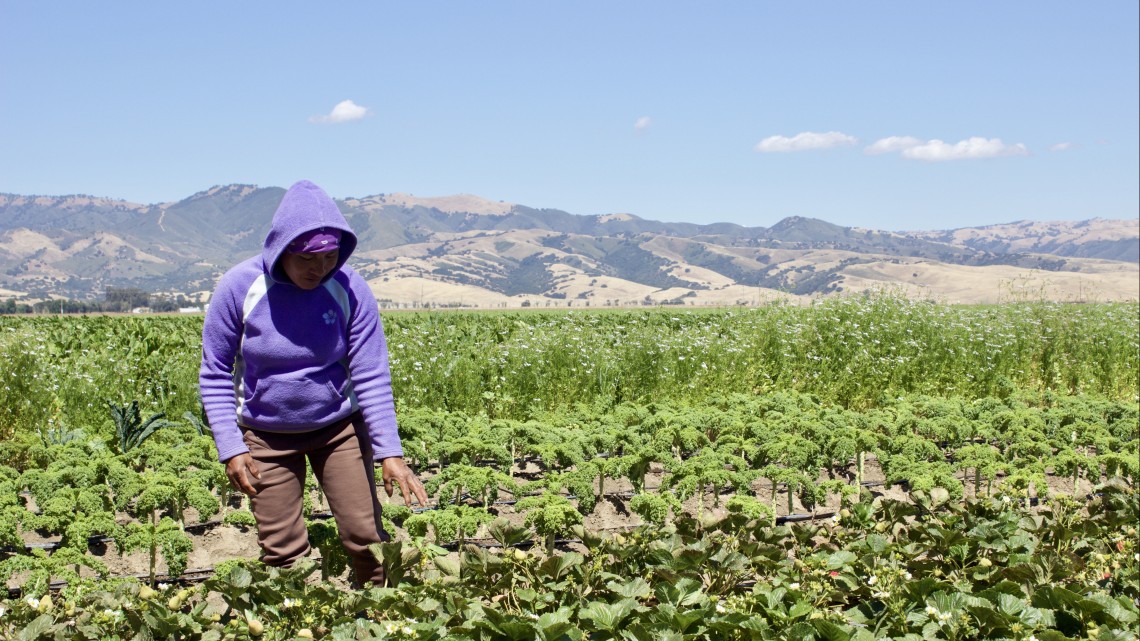
The flowering cilantro behind this small-scale organic farmer in California attracts natural enemies of some brassica pests. The use of insectary plantings like these flower strips is one of eight agroecological practices tracked by a new Cornell study.
Sustainable practices linked to farm size in organic farming
By Caitlin Hayes, Cornell Chronicle
Larger organic farms operate more like conventional farms and use fewer sustainable practices than smaller organic farms, according to a new study that also provides insight into how to increase adoption of sustainable practices.
“We wanted to look at how the practices differ between small-scale organic farms like the ones you see scattered around the Finger Lakes, which may serve the local farmer’s market, and those huge farms that supply organic produce to big box stores,” said Jeffrey Liebert Ph.D. ’22, who studied agroecology at the School of Integrative Plant Science, Soil and Crop Sciences Section, in the College of Agriculture and Life Sciences. “I visited numerous large farms where their organic acreage was on one side of the road and their conventional acreage on the other side, and you couldn’t tell the difference.”
Liebert is first author of “Farm Size Affects the Use of Agroecological Practices on Organic Farms in the United States,” published July 21 in Nature Plants.
He and an interdisciplinary group of researchers from Cornell, U.C. Berkeley, and The Nature Conservancy surveyed 542 organic fruit and vegetable farmers about the use of eight agroecological practices – those that improve sustainability by leveraging ecological processes and providing ecosystem services. They also looked at indicators of ‘conventionalization’ in organic farming, such as reduced crop diversity, mechanization and a focus on high volume and wholesale production.
They found that, on average, the larger farms used fewer agroecological practices and that organic farming on large farms more closely resembled conventional farming, with growers often substituting synthetic pesticides and fertilizers with inputs permitted in organic production, rather than redesigning their farms to integrate a broader suite of sustainable agroecological practices.
U.S. organic fruit and vegetable sales represent 15% of all retail produce sales, and organic food sales total nearly $57 billion a year. While large farms in the organic market could drive prices down and expand access, the use of fewer agroecological practices and greater degree of conventionalization could reduce the sustainability of organic agriculture and confidence in the organic label, the authors said.
“This conventionalization of organic farming is a real issue,” said Matthew Ryan, associate professor in the School of Integrative Plant Science and co-author of the paper. “If it goes too far, then consumer confidence in the organic label will dissipate, you lose that price premium, people won’t be using these practices – and we’ll lose those ecosystem services and benefits.”
The researchers found that larger farms were more likely to use agroecological practices that primarily increased efficiency. For example, reduced tillage, which minimizes disturbance to soil but also requires specialized equipment, was more common on larger farms. Smaller farms were more likely to use non-crop vegetation; for example, they were almost three times more likely than large farms to use insectary plantings, which attract beneficial insects.
There are a number of reasons large farms might not adopt agroecological practices, Liebert said. Insectary plantings on the perimeter of a very large field (versus a small field) might not be as effective for pollination, for example. In California, a program to incentivize the planting of hedgerows – which provide habitat for wildlife and beneficial insects – went south when food safety scares spooked large supermarket retailers; without adequate empirical evidence, farmers had to weigh the perceived risk of crop contamination from wildlife with the ecological and agricultural benefits. As a result, some farmers removed their hedgerows in order to keep their contracts with powerful wholesale buyers.
“This was a good example of how we can’t solve some of these issues around sustainability or biodiversity if you’re not taking a more interdisciplinary approach,” Liebert said. “If we’re not engaging in conversations with policymakers and the private sector, which has such a strong influence on the practices farmers are using, we won’t be successful in promoting the adoption of these practices.”
More research about how to scale up agroecological practices for large farms is needed, and the authors recommend tailoring incentive programs to large-, medium- and small-scale farmers. For example, programs could provide greater rewards to large farms that redesign – rather than simply substitute – elements of their management to incorporate agroecological practices.
The authors also recommend measures to protect small- and medium-size farms from the competition posed by large-scale organic farms. An additional finding of the survey was that, contrary to previous assumptions, small-scale organic farmers do feel competition from large farms, despite serving different markets.
“If we can help those medium- or small-sized farms gain access to alternative markets, and develop value-added products that lie outside the scope of direct competition with large farms, that could be impactful,” Liebert said.
Cornell co-authors include: Rachel Bezner Kerr, professor of global development; Thomas Björkman, professor in the School of Integrative Plant Science; Miguel Gómez, the Robert G. Tobin Food Marketing Professor in the Charles H. Dyson School of Applied Economics and Management and professor in the Department of Global Development, all in CALS; and Alison Power, professor of ecology and evolutionary biology in the College of Arts and Sciences. Support for the research came from the Cornell Atkinson Center for Sustainability.
Media Contact
Get Cornell news delivered right to your inbox.
Subscribe
